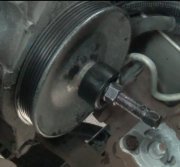If you fixed this yourself, it is most probable the upper strut mount is not in the correct location. That is critical for proper handling and steering response. Start by having the vehicle aligned. The problem here is your specialist is going to have to go deeper than we normally do, and you are going to have to tell him that.
The first three basic angles that are checked on all alignments are "camber", "caster", and "toe". Caster is not adjustable on your van, and it has very little affect on pulling on most front-wheel-drive vehicles. Caster will be wrong if the upper mount is too far forward or rearward from where it was. The most important thing is it has to be the same on both sides.
Camber will be wrong if the upper mount is too far to the left or right. Camber is adjustable on Chrysler's and GM's, but on most GM products one lower strut mounting hole has to be ground to an oval shape to allow that adjustment to be made if that has not been done already.
The issue here is simply readjusting camber, if it is wrong, is not going to solve this problem. The numbers might look good on the alignment computer, but adjusting that does not address the underlying problem. Your mechanic is going to have to look at "steering axis inclination", (SAI). All alignment computers measure that automatically when caster is measured, but we never think to look at it unless we are looking for the cause of an elusive problem. SAI is the tilt, or angle of the strut as it leans in on top. More accurately, it is the imaginary line drawn through the upper and lower steering pivot, which on your van is the lower ball joint and the upper strut mount. There is no spec given for SAI. All that is critical is both sides must be the same, typically within 0.2 degrees. A typical value might be 28 degrees.
When you move an upper strut mount in on top, that makes the wheel tip in. You can go down to the bottom of the strut and make a camber adjustment to fix camber, but that doesn't address the incorrect SAI. That is where the miserable handling comes from.
GM has another common problem related to SAI. To service their drive trains, they have to be lowered on the cross member. Some cross members on other car brands are welded in place. Some, like Chrysler's, are installed with bolts with shoulders that position the cross member. GM is the only one where there is nothing to keep the cross member positioned properly. If it is removed without first marking its location, the only way to get it back is on the alignment rack. Making the adjustment is not difficult, but you have to know about it.
When SAI is unequal on both sides, the vehicle might drift or pull, but where unequal camber is normally the most influential contributor to a pull, SAI adds a major unpredictability factor to that pull. The vehicle will tend to dart to either side when going over small bumps in the road. What it does one time might be exactly the opposite of what it does the next time. You won't want to drive a vehicle with unequal SAI for very long.
Monday, February 22nd, 2016 AT 10:11 AM


